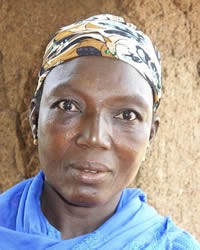Nanumba in Ghana

Photo Source:
Copyrighted © 2025
Kerry Olson All rights reserved. Used with permission |
Send Joshua Project a map of this people group.
|
| People Name: | Nanumba |
| Country: | Ghana |
| 10/40 Window: | No |
| Population: | 83,000 |
| World Population: | 83,000 |
| Primary Language: | Dagbani |
| Primary Religion: | Islam |
| Christian Adherents: | 0.20 % |
| Evangelicals: | 0.10 % |
| Scripture: | Complete Bible |
| Ministry Resources: | Yes |
| Jesus Film: | Yes |
| Audio Recordings: | Yes |
| People Cluster: | Gur |
| Affinity Bloc: | Sub-Saharan Peoples |
| Progress Level: |
|
Introduction / History
The Nanumba are their own cultural and linguistic group, but they are closely related to the Dagomba, a larger tribe. The Nanumba are located in eastern Ghana, primarily in the northern part of the Bimbila district, between the White Volta and Oti Rivers. They are especially concentrated in Bimbilla, their capital town.
What Are Their Lives Like?
Most of the Nanumba are farmers. They grow yams, peanuts and corn. Most farm work is done by the men; however, the women often assist in harvesting. The Nanumba also have side occupations such as weaving and carving. They trade crafted goods and as a means of subsidizing their meager agricultural earnings. Some of the Nanumba men also leave their homes for several months to work on southern cocoa plantations. Hunting and fishing are also important, and the meat is shared among all of the villagers. They have a relatively low standard of living. Kerosene stoves are available, but other commodities such as electricity and pure drinking water remain very poor. Their women draw water from a dammed river. Their tainted water causes bone diseases due to the water-borne Guinea worms. The Nanumba live in compact, oval-shaped, walled villages. Each household consists of related men, their wives and their children. Their round, clay huts must be rebuilt every five years due to rain damage. The villages have no central building. The chief owns the land and leases portions of it to each family. The Nanumba have a large family system, which is divided into hierarchically arranged clan units. The clan elders exercise moral authority over their units. The chief, who can only be the son of a previous chief, controls the judicial system, while the police enforce social control. The society is patrilineal, which means that the line of descent is traced through the males. However, spiritual attributes are recognized matrilineally, or through the females. The children go to school when they reach the age of six; however, their primary duties include housework. While they appear to be a sedate farming people, the Nanumbas have been engaged in power struggles with surrounding tribes for centuries. Their battles have been so serious that it has reduced their population at times. They consider themselves to be an independent people and are highly resistant to any attempts to influence their social behavior or spiritual beliefs. The most famous festival among the Nanumba is the Yam Festival. During this celebration they enjoy singing and dancing.
What Are Their Beliefs?
The majority of the Nanumba people are Muslims, but their form of Islam is tainted by traditional religion. They believe that the creator is unapproachable, so they look to local spirits for their daily needs. They are involved with idol and ancestor worship.
What Are Their Needs?
The Nanumba people need additional missionaries and medical teams. They do not have a system for pure drinking water which results in bone diseases.
Prayer Points
Pray for the Lord to send people who can help the Nanumba people with their water needs. Pray for the Lord to give the Nanumba people an abundant harvest this year as a testimony of his goodness and power. Pray for the Holy Spirit to move on Nanumba hearts so they will seek and find the only Savior. Pray for a movement to Christ among this people group.